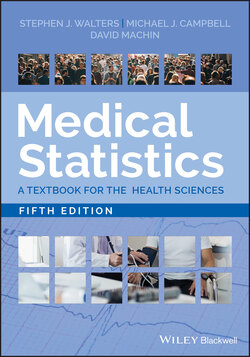Читать книгу Medical Statistics - David Machin - Страница 107
Illustrative Example – Normal Distribution – Birthweights
ОглавлениеUsing the birthweight data from the O'Cathain et al. (2002) study let us assume that the birthweight for new born babies has a Normal distribution with a mean of 3.4 kg and a standard deviation of 0.6 kg. So, what is the probability of giving birth to baby with a birthweight of 4.5 kg or higher?
Since birthweight is assumed to follow a Normal distribution, with mean of 3.4 kg and SD of 0.6 kg, we therefore know that approximately 68% of birthweights will lie between 2.8 and 4.0 kg and about 95% of birthweights will lie between 2.2 and 4.6 kg. Using Figure 4.13 we can see that a birthweight of 4.5 kg is between one and two standard deviations away from the mean.
Figure 4.13 Normal distribution curve for birthweight with a mean of 3.4 kg and SD of 0.6 kg.
First calculate, Z, the number of standard deviations 4.5 kg is away from the mean of 3.4 kg, that is, . Then look for z = 1.83 in Table T1 of the Normal distribution table, which gives the probability of being outside the values of the mean −1.83SD to mean +1.83SD as 0.0672. Therefore the probability of having a birthweight of 4.5 kg or higher is 0.0672/2 = 0.0336 or 3.4%.
The Normal distribution also has other uses in statistics and is often used as an approximation to the Binomial and Poisson distributions. Figure 4.4 shows that the Binomial distribution for any particular value of the parameter π approaches the shape of a Normal distribution as the other parameter n increases. The approach to Normality is more rapid for values of π near 0.5 than for values near to 0 or 1. Thus, provided n is large enough, a count may be regarded as approximately Normally distributed with mean nπ and . The Poisson distribution with mean λ approaches Normality as λ increases (see Figure 4.5). When λ is large a Poisson variable may be regarded as approximately Normally distributed with mean λ and SD = √λ.
